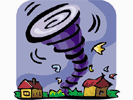 Teacher
Guide to Hurricanes and Tornadoes
Teacher
Guide to Hurricanes and Tornadoes
Hurricanes and tornadoes have quite a lot in common, but they are actually two different climatic conditions. You must have linked both with each other at times, but you have to know that their causes and nature is very different. Let's take a look at both of them separately.
Hurricanes are created in oceans and then move towards the land. However, they start losing strength when they are near the coast. There are three birth factors of hurricanes, which are: tropical depression, fierce hurricane and tropical storm. Tropical depression is formed when the surface of the water becomes hot after a storm. Tropical depression converts into a tropical storm as soon as it reaches 39 mph, and it turns into a hurricane as soon as it reaches the speed of 75 mph. Did you know that the mid point of a hurricane is known as the eye of hurricane? Well, now you do. Hurricanes are known by different names around the globe. The ones that occur in the Atlantic Ocean and the Pacific Ocean are known as hurricanes, whereas the ones that occur in the Indian Ocean are known as cyclones.
Tornadoes, unlike hurricanes, are born in regions that are dry and windy. A tornado forms in a spiral from top to bottom. Many believe that tornadoes form from the ground and all the way up to the sky, but they actually form from the skies and downwards. They form when cold air pushes the warm air upwards. The eye of tornado forms from the top in the shape of a funnel. Tornadoes are so fast! Their speed is more than 100 mph, and that is why they can abduct anything that comes in their way, be it a house, a bridge or anything.
Let's check out the differences between tornadoes and hurricanes:
- The first difference is that tornadoes are born in dry land whereas hurricanes form in tropical lands.
- The second difference is that a tornado is a type of wind storm, whereas a hurricane is born in water but has an effect on the winds. Once a tornado is born in an ocean, the regions that touch the coast are affected with heavy rainfalls, wind storms, etc.
- Tornadoes are quite speedy but linger for a short period of time. On the other hand, hurricanes can actually last for days. - Hurricanes gain strength gradually whereas tornadoes rapidly grow stronger.
- Usually tornadoes last for 10 minutes to an hour, but hurricanes can last for several weeks or days - Hurricanes keep on gaining strength, and when they are near the coast they start losing it. Once they are away from the coast, they again gain strength and the process continues until they totally finish. Tornadoes on the other hand gain strength rapidly, cause destruction and finish off in 10 - 60 minutes.
- Tornadoes cause damage with winds whereas hurricanes, when near the coast, can cause severe damage by giving birth to heavy rainfalls, wind storms and by hitting the coastal line with floods.
Hurricanes are much more powerful than tornadoes. They are fiercer and cause a great degree of harm to the coastal regions. Tornadoes last for comparatively a very short time; therefore you can easily stay safe from them if you know the necessary measures.
Related Teacher Resources That Are Worth A Look:
- Comparing Hurricanes and Tornadoes
- Hurricane and Storm Tracking
- Hurricanes and Tornadoes Lesson
- HurricaneTrack